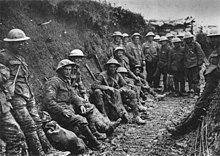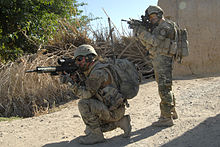British Armed Forces
![]()
This article is still missing the following important information:
History, nuclear arsenal, war crimes, general information, such as exact command and organizational structures / outline etc.. All in all, simply not detailed enough for a globally significant armed force! (cf. US Armed Forces)
Help Wikipedia by researching and adding them.
The armed forces of the United Kingdom (English designations: British Armed Forces, literally British Armed Forces, in official usage Her Majesty's Armed Forces or Armed Forces of the Crown) are the military of the United Kingdom. They are divided into three branches and comprise approximately 190,000 troops. They also employ civilian personnel. The Commander-in-Chief is de jure the monarch of the United Kingdom and de facto the Prime Minister of the United Kingdom.
Britain became the world's third nuclear power in 1952. British strategic nuclear weapons are stationed on Royal Navy submarines. Currently, they are Vanguard-class boats with intercontinental ballistic missiles of the Trident type, which was developed by the US.
History
See also: History of the British Army and History of the Royal Navy
Wars
The United Kingdom has a centuries-long colonial and imperial tradition, with soldiers stationed on every continent of the world. Britain was at times the world's largest empire, comprising a quarter of the world's land mass and population, and was the leading naval power in the 19th century. Many men from the British colonies also regularly served in the Empire's armed forces.
The most important war involvements since the birth of the British nation-state were the Seven Years' War (1756-1763), the Napoleonic Wars, the American War of Independence (1775-1783), the Crimean War (1853-1856) and the two World Wars. During the Second World War (1938-1945), some ten thousand German and Austrian nationals who fled their homelands for political or racial reasons also served in the British forces.
Today, British military units and advisers are mainly stationed in the former colonies or active in international missions.
Institutionalisation of the Ministry of Defence
Until 1940, different ministries were separately responsible for military affairs and for the branches of the armed forces. The British Ministry of Defence of today developed from a provisional arrangement during the Second World War, which was not institutionalised until 1964. It combined the powers of the Admiralty, the War Office and the Air Ministry.
Overload
The National Audit Office issued a report on November 3, 2006, stating that the military was chronically understaffed by 2 to 3 percent. The pace of operations tended to be too high. The Ministry of Defence replied that there were bottlenecks, but denied that the armed forces were overstretched.
Armed Forces Act 2006
On 30 November 2005, the House of Commons ratified the Armed Forces Act. The Act, which became law on 8 November when signed by the Queen, consolidated the statute books of all the armed forces and introduced new legislation.
Units of the armed forces were also regularly sent into combat operations after the Second World War. From 1968 to 2015, soldiers fell every year; there were no casualties in 2016.

English troops in the battle of Waterloo 1815

Units of the Royal Irish Rifles in the Battle of the Somme 1916

Royal Marines in Sangin, Afghanistan 2010
Order
The UK Armed Forces are tasked with protecting the UK homeland as well as overseas territories, enforcing UK security interests and participating in multinational peacekeeping missions. By definition, the UK Armed Forces consider themselves committed to the international community.
The British government describes integration into NATO structures as existential for its defence policy.
Strategy
In July 1998, a year after the new Labour government took office, the UK Ministry of Defence published a strategic policy paper called the Strategic Defence Review (SDR), which reconceived the country's defence policy. This reorientation contrasted with two previous documents called Options for Change in 1990 and Front Line First in 1994, which were primarily concerned with downsizing the armed forces. In 2002, in response to the terrorist attacks of September 11, 2001, the Department of Defense published a supplement to the Strategic Defense Review, the New Chapter, and in 2003 issued an expansion of the SDR called Delivering Security in a Changing World.
Questions and Answers
Q: What are the three parts of the British Armed Forces?
A: The British Armed Forces is made up of three parts: the British Army, the Royal Navy (and the Royal Marines) and the Royal Air Force.
Q: Who is the Commander-in-Chief of the British Armed Forces?
A: The Commander-in-Chief of the British Armed Forces is the British monarch.
Q: What does a member of the British Armed Forces have to swear?
A: Members of the British Armed Forces must swear that they will obey orders from their monarch (swear allegiance).
Q: How often does Parliament pass an Armed Forces Act?
A: Parliament passes an Armed Forces Act every five years.
Q: Who is responsible for managing and controlling Britain's armed forces?
A: The armed forces are managed by Britain's Ministry of Defence.
Q: What missions do members of Britain's armed forces take part in? A: Members of Britain's armed forces take part in United Nations peacekeeping missions, NATO missions, and other military operations such as wars in Afghanistan and Iraq, Operation Palliser, peacekeeping in Balkans and Cyprus, and defending no-fly zones over Libya.
Q: Where are some bases located for Britain's armed forces? A: Some bases for Britain's armed forces can be found in Ascension Island, Belize, Brunei, Canada, Diego Garcia, Falkland Islands, Germany Gibraltar Kenya Qatar and Sovereign Base Areas (Cyprus).
Search within the encyclopedia